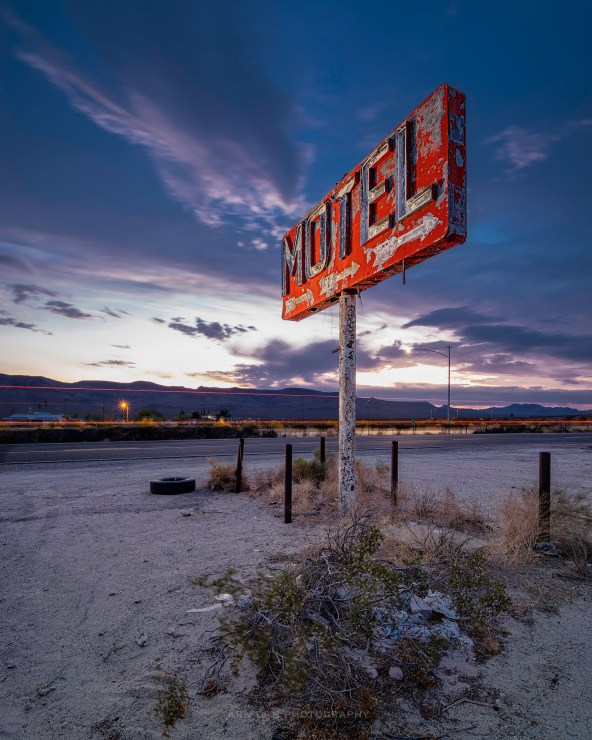I love old signs, especially if they are located along the Mother Road, Route 66. I had two locations to get to for night photography. I thought I would photograph some historic signs in Yucca, AZ, and then drive west to another Route 66 location an hour away.
I photographed this during Blue Hour, a time when many of the colors of the sky come alive in deep hues.
A brief history
Like many of the towns along Route 66, Yucca thrived, serving the needs of motorists heading west. And when the Interstate Highway system was put in, motorists bypassed the businesses in Route 66. Many of those businesses eventually evaporated, often abandoned along the route.

Three steps to light painting the sign
1. Adjusting the light for light painting during blue hour
I was photographing approximately during blue hour, about 25 minutes after the sun had set behind the mountains. Therefore, I needed a much stronger light than I typically need for light painting near a full moon. I also wanted a warm white light. I set the ProtoMachines LED2 for its strongest setting. I mixed in some yellow color for good measure.
2. Determining the best angle for light painting the sign
It’s important to consider the directionality of the already existing light when light painting if one wants the photo to look slightly more natural. Here, the light was coming from the horizon, already illuminating the sign from that direction. I wanted more of that.
I stood closer to the road. Shielding my handheld ProtoMachines LED2 light painting device, I illuminated the sign at approximately the same angle. This would create additional contrast while looking natural.
3. Waiting for the right moment to open the shutter
I set my Pentax K-1 camera for a 20-second exposure at f/14. This was in part because I wanted to illuminate the sign for a decent amount of time. But it was also so that I could begin the long exposure with enough time to make sure that I got red streaks of light from a passing truck. I wanted the red taillights in particular because I felt they would match really nicely with the sign. That simply meant waiting until a truck was driving north, then beginning the long exposure.
Tell your story with the second annual Visual Storytelling Conference!
Experience four days of interactive, online training sessions featuring a range of educational content with experienced photographers and content creators. This free event kicks off with a series of technical boot camps to build essential skills, followed by live, online sessions on photography, video, business and social media. Join live from March 10-13, 2022!
